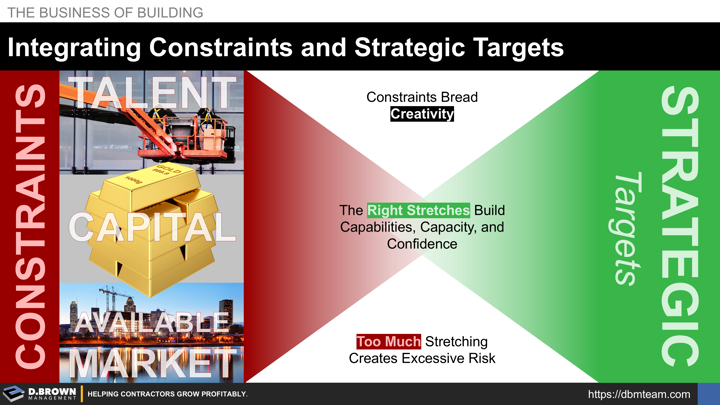We can survive for days without water and weeks without food, but if blood flow stops, we lose consciousness within seconds, and death follows in minutes.
"Targets should be determined by what is needed, not by what is achievable." - Isao Yoshino (Learning to LEAD, and Leading to LEARN)
The first of the five interlinked questions that define your strategy is: What are our broad aspirations for our organization & the concrete goals against which we can measure our progress?
These concrete goals will be integrated into your 3-Year Plan and Business Model.
When you first create these plans, your three-year outlook may seem unrealistic—especially your one-year milestones. Embrace this discomfort and continue working through the constraints in your business with your team, consistently including the three basic constraints.
- Available talent in the market
- Available capital, including borrowing ability and bonding capacity
- Available work in the market(s) you have chosen to pursue
"Most people overestimate what they can do in one year and underestimate what they can do in ten years." - Bill Gates
"All overnight success takes about 10 years." - Jeff Bezos
BALANCE IS KEY
- Constraints breed creativity.
- The right constraints and creative stretches build capabilities, capacity, and confidence.
- Too much stretching creates excessive risk.
Imagine your business without constraints.
- What would it look like if qualified talent was rushing to your door?
- Alternatively, what would it look like if you found a way to do 25% more work with the same talent?
- Or, if you structured a project team so that more than half the work could be effectively completed by people with two years or less of experience?
- What if your profitability increased so that you generated enough additional working capital each year, so capital was never a constraint to your growth?
- Alternatively, what if you adjusted some of your processes, starting with customer selection and contract terms, so that your projects were cash flow positive within the first 60 days?
- Or, what if you did both?
- Even if you were only half successful at both, what if this combination unlocked your ability to continue growing profitably and safely?
- What if you realized you were only seeing a fraction of the opportunities in the market? That's often the harsh truth about business development.
- Alternatively, what if you were able to identify additional market sectors, scopes of work, or geographies that required the capabilities you already have built?
These are all possibilities for many contractors.
An unbiased, experienced third party can be invaluable in helping your team identify the constraints, prioritize them, design solutions, and execute.
We keep pressure on your vision.
All relationships begin with a simple conversation - let's talk.

